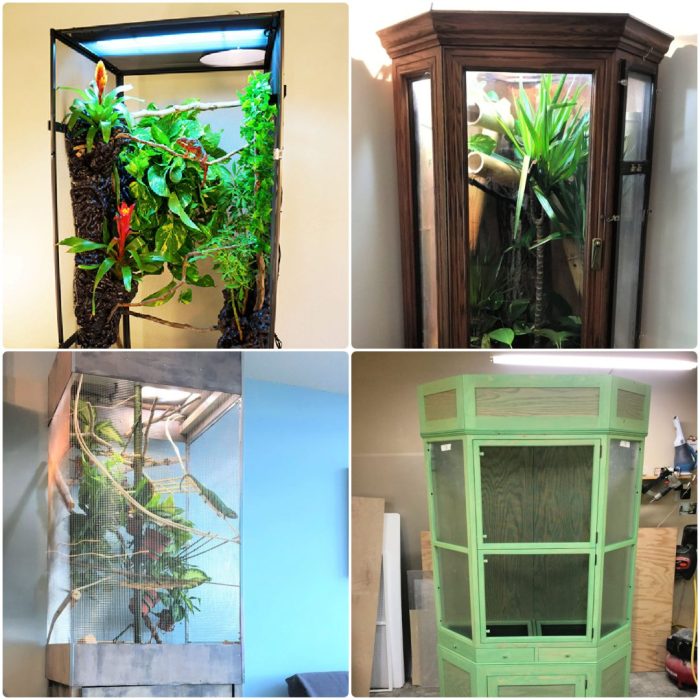DIY Chameleon Cage: A captivating journey into the world of reptile care, this guide offers practical advice and creative solutions for building a thriving habitat for your chameleon. Dive into the fascinating world of chameleon needs, from temperature and humidity control to creating a visually stimulating environment that mirrors their natural surroundings. Explore the essential components of a successful DIY cage, learn about different design options, and discover the secrets to keeping your chameleon healthy and happy.
Table of Contents
This comprehensive guide provides a step-by-step blueprint for building a DIY chameleon cage, addressing all aspects of chameleon care. From understanding their basic needs to selecting the right materials and designing a safe and stimulating environment, this resource empowers you to create a custom habitat that meets your chameleon’s specific requirements.
Lighting and Heating Requirements: Diy Chameleon Cage
Providing appropriate lighting and heating is crucial for the well-being of your chameleon. Chameleons are ectothermic, meaning they rely on external sources of heat to regulate their body temperature. Proper lighting and heating ensure optimal health, digestion, and activity levels.
Types of Lighting
There are two main types of lighting essential for chameleon enclosures: UVB and basking lights.
- UVB Lighting: UVB rays are essential for the synthesis of vitamin D3 in chameleons, which is crucial for calcium absorption and bone health. UVB lights should be specifically designed for reptiles and emit UVB rays in the appropriate spectrum (UVB 5.0 or 10.0).
- Basking Lights: Basking lights provide a heat source for chameleons to regulate their body temperature. They are typically incandescent bulbs or ceramic heat emitters. These lights should be positioned to create a basking spot with a temperature gradient within the enclosure.
Types of Heating
There are several methods for providing heat to a chameleon enclosure:
- Under Tank Heaters (UTH): These heaters are placed underneath the enclosure and provide a consistent heat source. UTHs are typically used to maintain a general ambient temperature within the enclosure.
- Ceramic Heat Emitters (CHE): CHEs are similar to incandescent bulbs but do not emit visible light. They are excellent for providing heat at night without disturbing the chameleon’s sleep cycle.
- Heat Lamps: Incandescent or halogen lamps can be used as a heat source for basking. They are typically placed above the enclosure and directed toward a basking spot.
Selecting the Correct Wattage and Placement
The wattage of lighting and heating devices should be selected based on the size of the enclosure and the desired temperature gradient.
- Wattage: A higher wattage bulb will produce more heat. The appropriate wattage will depend on the size of the enclosure, the ambient temperature, and the type of heating device.
- Placement: The placement of lighting and heating devices is crucial to create a proper temperature gradient within the enclosure. The basking spot should be the warmest area, with temperatures gradually decreasing as you move away from the heat source.
Temperature Gradient: A temperature gradient is essential for chameleons to regulate their body temperature. It allows them to choose a spot that is comfortable for them. The basking spot should be around 85-90°F (29-32°C), while the cooler end of the enclosure should be around 75-80°F (24-27°C).
Water and Hydration

Providing adequate water sources is crucial for the health and well-being of your chameleon. Chameleons primarily obtain water through licking droplets of water from surfaces, rather than drinking from a bowl like other reptiles. Therefore, it’s essential to create a humid environment and offer various methods for them to access water.
Different Hydration Methods
Several methods can be employed to ensure your chameleon stays hydrated.
- Drip Systems: Drip systems are an effective way to provide a constant source of fresh water for your chameleon. These systems consist of a small reservoir that slowly drips water onto a plant or other surface within the enclosure. The dripping water attracts the chameleon’s attention, encouraging them to lick the droplets.
- Misting: Misting the enclosure regularly is another vital method for keeping your chameleon hydrated. You can use a hand-held mister or an automatic misting system to create a fine mist that settles on the plants and surfaces within the cage. Chameleons will readily lick these droplets, particularly in the morning or evening when humidity levels are lower.
Monitoring Hydration Levels, Diy chameleon cage
It’s essential to monitor your chameleon’s hydration levels to ensure they are receiving enough water. Signs of dehydration include:
- Sunken eyes: Dehydrated chameleons will have eyes that appear sunken into their sockets.
- Lethargy: A chameleon that is dehydrated will appear sluggish and less active.
- Wrinkled skin: Dehydration can cause the chameleon’s skin to become wrinkled or loose.
- Loss of appetite: A dehydrated chameleon may lose interest in food.
Cage Maintenance and Cleaning

Maintaining a clean and hygienic environment is crucial for your chameleon’s health and well-being. Regular cleaning helps prevent the buildup of bacteria, mold, and parasites, which can lead to various health issues.
Cleaning Frequency
The frequency of cleaning your chameleon’s cage depends on several factors, including the size of the cage, the number of chameleons, and the type of substrate used. However, a general guideline is to spot clean the cage daily and perform a thorough cleaning every 1-2 weeks.
- Spot Cleaning: Remove any uneaten food, feces, and shed skin daily. This helps to prevent the accumulation of waste and reduces the risk of bacteria and mold growth.
- Thorough Cleaning: A deep clean involves removing all cage furnishings, including branches, plants, and water dishes. Scrub the cage walls, floor, and all accessories with a reptile-safe disinfectant.
Cleaning Solutions
Using the right cleaning solutions is essential for maintaining a safe and healthy environment for your chameleon.
- Reptile-Safe Disinfectant: Avoid using harsh chemicals like bleach or ammonia, which can be toxic to chameleons. Opt for a disinfectant specifically designed for reptiles, available at pet stores.
- Warm Water: Warm water is an effective cleaning agent for most surfaces. Use a soft cloth or sponge to wipe down the cage and accessories.
- Vinegar: Diluted white vinegar can be used to remove stubborn stains and kill bacteria. Mix equal parts vinegar and water, and use a soft cloth to apply the solution to the affected areas.
Sanitation Techniques
Proper sanitation techniques are crucial for preventing the spread of bacteria and parasites.
- Rinse Thoroughly: After cleaning with a disinfectant, rinse the cage and accessories thoroughly with clean water to remove any residue.
- Allow to Dry Completely: Ensure that all surfaces are completely dry before placing your chameleon back in the cage. Dampness can encourage the growth of bacteria and mold.
- Wash Hands: Always wash your hands thoroughly with soap and water after handling your chameleon or cleaning the cage. This helps to prevent the spread of germs.
Preventing Bacteria and Mold Buildup
Regular cleaning is essential for preventing the buildup of bacteria and mold.
- Choose a Suitable Substrate: Some substrates, such as coconut coir or paper towels, are more prone to mold growth than others. Consider using a substrate that is less susceptible to mold.
- Proper Ventilation: Ensure that your chameleon’s cage has adequate ventilation to prevent the buildup of humidity, which can encourage mold growth.
- Clean Water Dishes: Change the water in your chameleon’s water dishes daily and clean them thoroughly with a reptile-safe disinfectant.
Safety Considerations
A DIY chameleon cage requires extra attention to safety to ensure the well-being of your pet. By carefully selecting materials, constructing the enclosure securely, and taking precautions against potential hazards, you can create a safe and comfortable environment for your chameleon.
Using Non-Toxic Materials
It’s crucial to use materials that are non-toxic and safe for your chameleon. Avoid using materials that could release harmful chemicals or fumes into the cage environment.
- Avoid using treated wood: Pressure-treated lumber or wood treated with chemicals can release toxins that can harm your chameleon. Opt for untreated wood or use alternative materials like PVC or metal.
- Choose non-toxic paints and finishes: If you need to paint or stain the cage, select paints specifically designed for use with reptiles. These paints are formulated to be non-toxic and safe for animals.
- Use safe adhesives and sealants: When assembling the cage, use adhesives and sealants that are safe for reptiles. Avoid products containing volatile organic compounds (VOCs) that can release harmful fumes.
Avoiding Sharp Edges
Sharp edges can pose a risk to your chameleon, potentially causing cuts or injuries. Smooth out any rough or sharp edges on the cage structure, branches, or other accessories.
- Sand down any rough edges: Use sandpaper or a sanding block to smooth out any sharp edges on the wood or metal components of the cage.
- Cover sharp corners: If you can’t completely eliminate sharp corners, use protective coverings like silicone or rubber to prevent your chameleon from getting hurt.
- Inspect branches regularly: Ensure that branches used in the cage are smooth and free of any sharp points or splinters.
Securing the Cage and Preventing Escapes
A secure cage is essential to prevent your chameleon from escaping and potentially getting injured or lost. Consider the following measures to ensure the safety of your chameleon:
- Use secure fasteners: When assembling the cage, use strong and secure fasteners, such as screws or bolts, to ensure the cage is sturdy and won’t easily come apart.
- Secure the lid tightly: The cage lid should be securely fastened to prevent your chameleon from escaping. Consider using latches or clips to ensure a tight seal.
- Use mesh or wire screens: The cage should be constructed with fine mesh or wire screens to prevent your chameleon from squeezing through openings.
Resources and Further Information

It is important to remember that caring for a chameleon is a long-term commitment. While this guide provides essential information, continuous learning and research are crucial for ensuring your chameleon’s well-being.
Reputable Websites and Resources
The internet offers a wealth of information on chameleon care. It is important to rely on reputable sources for accurate and up-to-date information.
- The Chameleon Information Network (CIN): This website offers a comprehensive collection of information on chameleon care, including species-specific guides, husbandry advice, and health resources.
- The Reptile Database: This database provides detailed information on chameleon species, including their natural habitat, diet, and care requirements.
- The American Society of Herpetologists and Reptile Keepers (ASHS): This organization offers a wealth of information on reptile care, including resources on chameleon husbandry.
Local Reptile Veterinarians and Breeders
Finding a veterinarian experienced in reptile care is essential for your chameleon’s health.
- The Association of Reptilian and Amphibian Veterinarians (ARAV): This organization provides a directory of reptile veterinarians across the United States. You can use their website to find a veterinarian in your area who specializes in reptile care.
- Local reptile breeders: Reptile breeders often have a wealth of knowledge about chameleon care and can provide valuable advice on finding a healthy chameleon and setting up a suitable enclosure.
Importance of Ongoing Research and Learning
Chameleon care is a constantly evolving field, with new research and best practices emerging regularly. It is crucial to stay informed about the latest developments in chameleon husbandry to ensure you are providing the best possible care for your pet.
“The more you learn about chameleon care, the better equipped you will be to provide a healthy and happy environment for your pet.”
Building a DIY chameleon cage is a rewarding experience that allows you to provide a personalized and enriching environment for your beloved reptile. By following the guidelines Artikeld in this guide, you can create a safe, stimulating, and comfortable habitat that will promote your chameleon’s health and well-being for years to come. Remember, ongoing research and continuous learning are essential for ensuring your chameleon thrives. With a little creativity and dedication, you can build a truly extraordinary home for your chameleon, a place where they can flourish and exhibit their unique charm.
Building a DIY chameleon cage can be a rewarding project, allowing you to create a perfect habitat for your scaly friend. Just like crafting a DIY caterpillar costume for a child’s play, you’ll need to consider the right materials and construction techniques to ensure a safe and stimulating environment for your chameleon. With some planning and effort, you can build a cage that is both functional and visually appealing.


